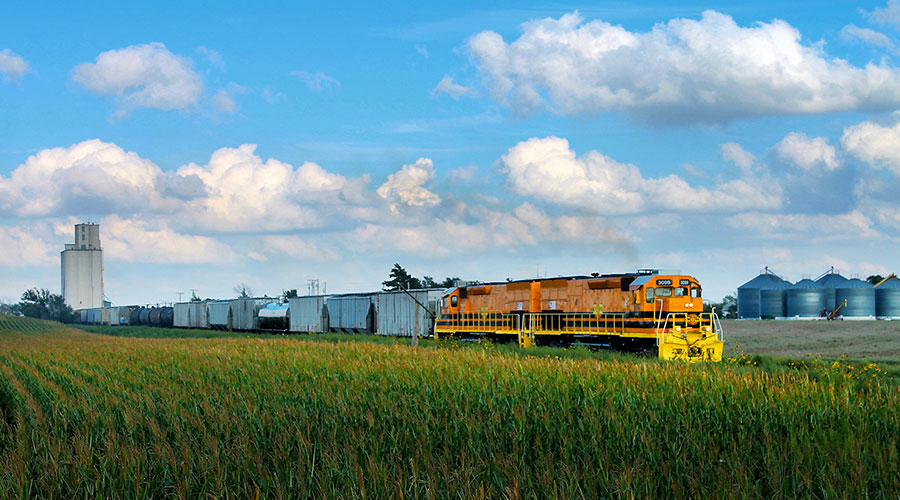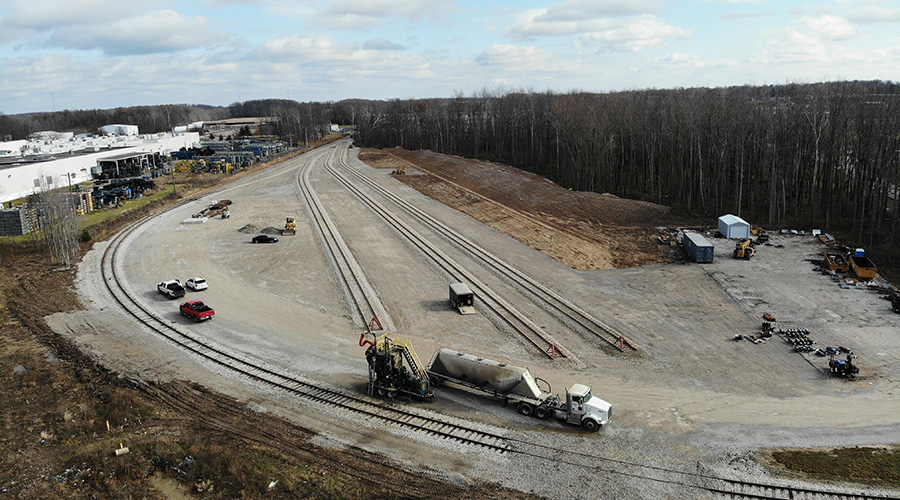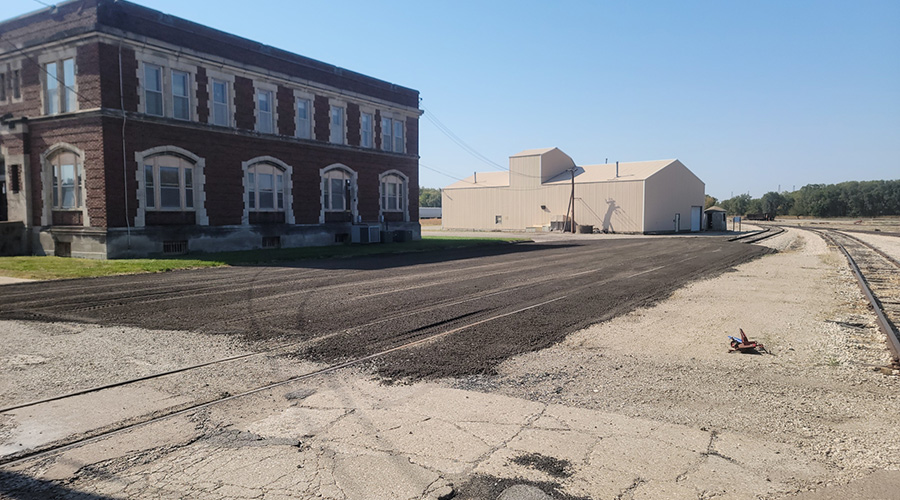Traffic in 2023 came up short for some small roads, exceeded expectations for others
1/12/2024
By Jeff Stagl, Managing Editor
The traffic outcome for a majority of regionals and short lines in 2023 mirrored the collective fate of both U.S. and Canadian railroads as reported recently by the Association of American Railroads (AAR).
Last year, U.S. roads logged 24,369,229 carloads and intermodal units, down 2.3%, and Canadian railroads registered 8,299,862 carloads and intermodal units, down 2.4% compared with 2022 totals, the AAR said.
Similarly, carloads fell 2.4% year over year to 6,658,262 for 465 reporting regionals and short lines, according to the RailConnect Index of Shortline Traffic compiled by Wabtec Corp.’s GE Transportation subsidiary. The index covers a 52-week period ending Dec. 30, 2023.
The biggest laggards were coal carloads, which plummeted 18.7% to 311,414 units; paper products loads, which plunged 14.4% to 316,632 units; grain carloads, which fell 5.7% to 694,723 units; lumber and forest products loads, which dropped 5.3% to 286,118 units; and intermodal loads, which declined 5.1% to 1,248,184 units.
The small railroads also logged year-over-year decreases in the following commodity groups: ores (0.9% to 157,044 units), stone, clay and aggregates (0.7% to 727,106 units), and chemicals (0.1% to 1,229,800 units).
 Agriculture carloads last year declined by 9,800 units for Watco’s Kansas & Oklahoma Railroad because of a severe drought in the U.S. Plains. Watco
Agriculture carloads last year declined by 9,800 units for Watco’s Kansas & Oklahoma Railroad because of a severe drought in the U.S. Plains. WatcoHowever, they managed to post traffic gains in six of 14 groups, led by motor vehicles and equipment (up a whopping 25.1% to 208,651 units) and “all other” traffic (up 14.5% to 107,912 units). Metals and products traffic rose 5.4% to 478,636 units; petroleum and coke loads increased 2.6% to 241,621 units; and farm and food products (excluding grain) carloads inched up 1.5% to 311,823 units. Waste and scrap metal movements were essentially flat, up only 0.07% to 338,598 units.
With last year’s mostly weak carload figures as a backdrop, RailPrime reached out to a number of regionals, short lines and holding companies to learn how their traffic fared in 2023, and what drove or hindered it. Following are summations gleaned from phone calls or emails.
Repeat is quite a feat
The traffic results were surprising — in a good way — for some, including the Reading, Blue Mountain and Northern Railroad (R&N). The 400-mile Pennsylvania regional scored a double-digit percentage gain in carloads for the second-straight year.
Volume eclipsed 37,000 freight cars — up 12.1% from 33,000 cars in 2022 — primarily because of a significant increase in anthracite coal loads and a new frac sand terminal in Tunkhannock, which doubled carloads in its second full year of operation. R&N handled more than 1 million tons of anthracite coal in a given year for the first time in its 33-year history.
Coal and frac sand account for about half of the regional’s traffic base, which also includes forest products, petrochemicals and minerals, food and agricultural products, metals and consumer products. R&N — which marked its 40th anniversary in 2023 — also owns a warehouse, various transload facilities and a trucking firm that support its core rail business.
It also was another banner year for Sierra Northern Railway. The northern California short line boosted traffic 20% compared with carloads in 2022, which was a strong volume year, said Sierra Northern Railway President and CEO Kennan Beard.
The short line notched growth across the board at all three of its divisions: West Sacramento, Oakdale and Santa Paula. Sierra Northern operates 75 miles of track and several branch lines, and interchanges with BNSF Railway Co. and Union Pacific Railroad.
“There was no single growth driver as we saw increases in grain, petroleum and lumber moves,” said Beard.
 A drought in Kansas that heavily affected grain crops negatively impacted traffic for G&W’s Kyle Railroad. Genesee & Wyoming Inc.
A drought in Kansas that heavily affected grain crops negatively impacted traffic for G&W’s Kyle Railroad. Genesee & Wyoming Inc.Sierra Northern logged its biggest volume increase from transload locations instead of “brick and mortar customers,” he said.
“I expect 2024 to be another spectacular year, with a new growth driver,” said Beard, adding that he couldn’t yet comment further.
Well past the pandemic
Last year was a good one for Tacoma Rail, too. The Washington state short line registered a 28.7% traffic gain, with total revenue moves climbing from 335,814 in 2022 to 432,486 in 2023.
“This was led by a strong recovery in merchandise traffic and a mild recovery in our international intermodal business following the malaise that COVID wrought for the three years from 2020 to 2022,” said Tacoma Rail Superintendent Dale King.
Owned by Tacoma Public Utilities, the short line operates 43 miles of track between Tacoma and Nisqually, Washington, and interchanges with BNSF and UP.
In addition, two new customers that the short line acquired in 2022 significantly ramped up their business in 2023, said King. Tacoma Rail in August 2022 began handling J.B. Hunt Transport’s domestic intermodal traffic, and in October 2022 Hyundai moved its import auto business from Portland, Oregon, to Tacoma.
Chalk up the Seminole Gulf Railway as another traffic winner in 2023. The south Florida short line really needed the win after incurring significant infrastructure damage from Hurricane Ian in September 2022.
Seminole Gulf Railway operates 118 miles of track between North Naples and Arcadia, and Oneco (Bradenton) and Sarasota, Florida, and interchanges with CSX. In 2023, the short line registered a 29% carload gain versus 2022’s mark.
“The driver was aggregates, which more than offset the losses experienced in certain commodities driven by our railroad essentially being destroyed (and subsequently rebuilt) in the wake of Hurricane Ian,” said Seminole Gulf Railway Executive Vice President Robert Fay.
Last year, cement production/roadbed work accounted for 66% of aggregates demand, with the remainder from riprap for a Florida Department of Transportation bridge rebuilding project and landscaping stone/brick work.
At OmniTRAX Inc., leaders characterize 2023 carloads as a “tremendous year of growth.” Traffic rose by a percentage in the high single digits.
The company — which owns and operates 30 regionals and short lines — noted traffic strength in grain, construction products and chemicals. However, traffic demand was weak in the paper products and lumber sectors, OmniTRAX leaders said.
Plains drought was a downer
For Watco, there were both good and bad traffic developments in 2023. The good: Carloads climbed 3.7% year over year to 907,674 units. The bad: Agricultural loads were the lowest in the short-line holding company’s history because of severe drought conditions last summer in Kansas and some neighboring states, said Jimmy Patterson, Watco’s senior VP of rail operations and sales.
“With that said ... chemicals, metals and minerals [loads] were the highest they’ve ever been in our history,” he said.
Founded in 1983, Watco owns and operates 45 regionals and short lines totaling 8,250 track miles.
 After Hurricane Ian destroyed much of the Seminole Gulf Railway’s infrastructure in late 2022, the Florida short line bounced back in 2023 with a 29% traffic gain. Seminole Gulf Railway
After Hurricane Ian destroyed much of the Seminole Gulf Railway’s infrastructure in late 2022, the Florida short line bounced back in 2023 with a 29% traffic gain. Seminole Gulf RailwayIn terms of last year’s drought, the biggest impact occurred in Kansas – 79% of the state’s land area was under some form of drought when the summer grain harvest started, Patterson said. In June 2023, more than two-thirds of Kansas’ wheat crop faced extreme or exceptional drought conditions.
“According to the Kansas Wheat Commission, wheat abandonment in 2023 was 29% of the planted acres, the highest since 1951,” said Patterson. “[Our] Kansas & Oklahoma Railroad alone was down 9,800 in agriculture carloads in 2023.”
Some relief was evident by September, but it came too late to help the winter wheat harvest that’s typically cut between June and August, he added. But it did help with fall crops of milo — which also is known as grain sorghum — corn and soybeans.
Genesee & Wyoming Inc. (G&W) also could have used some help last year not only with the drought in the Plains but with weak demand in several commodity groups that impacted North American operations. Those operations involve more than 100 regionals and shorts in 43 states and five Canadian provinces totaling more than 13,000 track miles.
The drought in Kansas affected traffic for G&W’s Kyle Railroad, while a number of subsidiaries dealt with soft pulp and paper volumes impacted by market conditions and specific mill production issues. Coal demand was a headwind, too.
“Excluding coal, 2023 carload volumes for G&W North America were up slightly versus 2022, despite the slowdown in the overall freight market [and] significant impact to our agriculture volumes,” said G&W North America CEO Michael Miller.
Better days ahead
“Down” is the keyword that describes Farmrail System Inc’s traffic in 2023. Although final carload figures haven’t yet been tabulated, the company’s traffic declined on a year-over-year basis, said Farmrail System CEO George Betke.
The company owns the 170-mile Farmrail Corp. and 178-mile Grainbelt Corp. In Oklahoma, and retains a joint-venture interest in Finger Lakes Railway Corp. In New York state.
However, better days lie ahead, Betke believes.
“The 2024 outlook so far is better, especially the oilfield component. Although the party line may be discontinuance of fossil fuels, on-the-ground evidence suggests otherwise,” he said.
Examples of that evidence: Increased Anadarko Basin oil production activity, a higher number of inbound frac sand unit trains and better moisture conditions for winter wheat, Betke said.
For a holding company in the East — which declined to be identified — traffic was both up and down significantly for a couple of its short lines last year.
One posted a more than 20% year-over-year gain primarily because of increased traffic — both inbound scrap and outbound rebar — for a local rebar manufacturer, while another registered a 20% year-over-year drop due to retooling at one facility and a drop off in storage-in-transit business.
On a smaller scale, one subsidiary’s traffic bumped up more than 1% because higher wine distribution volume offset decreases in lumber and glass for construction, and another’s fell more than 2% because an increase in road salt volume couldn’t overcome declines in grain and lumber.
Meanwhile, car volume dipped 2% for the Aberdeen Carolina & Western Railway (ACWR). A family-owned railroad that’s the largest privately held short line in North Carolina, ACWR operates 150 miles of track between Charlotte and Pinehurst and interchanges with CSX and Norfolk Southern Railway.
“What was interesting is we were trending up in the 5% range through the first half of the year. But as the year continued, it became apparent that a few of our customers' shipments were starting to slide,” said ACWR Director of Business Development Paul Hoben. “Fortunately, our transload business remained strong, which helped to offset some of those shipment losses.”
The reasons for last year’s volume drop were twofold: One customer made a strategic decision to pull back in a certain market segment, and the cyclical nature of grain and aggregates impacted both another customer and the ACWR, he said.
“I have been advised that both of these customers' shipments should return to past volumes in 2024,” said Hoben.
The New Orleans Public Belt Railroad’s (NOPB) total volume slipped last year, too. Owned by the Port of New Orleans, the short line operates 26 miles of mainline track and 75 miles of total track, and interchanges with six Class Is.
Last year, NOPB logged 329,703 units versus 351,003 units in 2022.
“However, those numbers reflect rail industry trends throughout the year. We did see positive volumes with our inbound industry loads to customers and our daily storage increased, as well,” said NOPB Press Secretary Kimberly Curth.
Ironhorse Resources Inc. — which owns and operates eight short lines/switching companies in the Southwest — also had a trying year. Cars totaled 28,132 in 2023, down 8% compared with 2022’s 30,650 cars.
The last quarter in 2023 was the worst traffic-wise, said Ironhorse Vice President of Operations and Safety Greg Wheeler.
“We saw a decrease in car volume for the 4th quarter. Most of decrease was due to mineral traffic being down,” he said.


